| Pages:
1
2 |
UnintentionalChaos
International Hazard
    
Posts: 1454
Registered: 9-12-2006
Location: Mars
Member Is Offline
Mood: Nucleophilic
|
|
ionic affinity question (can't think of the real term)
Concerning strong acids, or rather ions of strong acids, such as sulfate and chloride. I suppose, the term is electronegativity. Which is more
electronegative?
2NaCl + CuSO4 -> Na2SO4 + CuCl2 (copper chloride could be extracted with alcohol)
Does this occur or does nothing happen (on account of electronegativity)?
|
|
|
12AX7
Post Harlot
    
Posts: 4803
Registered: 8-3-2005
Location: oscillating
Member Is Offline
Mood: informative
|
|
Negativity doesn't have anything to do with it. The above reaction would proceed (with NaSO4.10H2O as the precipitate at a low enough temperature)
because Na2SO4 is less soluble than the other three.
Conversely, when the solution is hot, NaCl or CuSO4.5H2O would prefer to crystallize, as NaCl does not gain much solubility with temperature or CuSO4
is less soluble than CuCl2 or Na2SO4.
I take that back, the Na2SO4 solubility curve levels out a bit along 40-100C or so. As I recall, it's still more soluble than NaCl, so sodium would
prefer to form the chloride as water is evaporated.
The reason CuCl2 can be extracted from such a reaction is it has solubility in alcohol, where none of the other products do.
Tim
|
|
|
UnintentionalChaos
International Hazard
    
Posts: 1454
Registered: 9-12-2006
Location: Mars
Member Is Offline
Mood: Nucleophilic
|
|
sorry this was a severly low brain activity moment....i shoulda been able to answer that myself. sodium sulfate hits a max solubility of somewhere
around 50g/100gH2O at...i think about 32 C...then decreases and levels off at around 40g/100gH2O as the temperature increases. It is quite a strange
salt. made some the other day from epsom salts and sodium hydroxide...turns out to be a total pain to remove the Mg(OH)2 since it really likes to stay
suspended.
shoulda thought more. in solution all there are are ions (unless there is a precipitate formed) when it dries out im left with a heap of mixed dry
ions that tend to congregate into respective salts. In alcohol, the dry mix would yield CuCl2 because of its solubility in alcohol and nothing else.
(smacks head against wall)
Thanks for the hasty response though!
[Edited on 20-12-2006 by UnintentionalChaos]
|
|
|
12AX7
Post Harlot
    
Posts: 4803
Registered: 8-3-2005
Location: oscillating
Member Is Offline
Mood: informative
|
|
Ahh, MgCO3 hydrate falls out just fine for me. No sense in wasting good hydroxide besides!
Tim
|
|
|
chemoleo
Biochemicus Energeticus
    
Posts: 3005
Registered: 23-7-2003
Location: England Germany
Member Is Offline
Mood: crystalline
|
|
| Quote: | because Na2SO4 is less soluble than the other three.
|
Are you sure this is entirely a function of solubility???
I'd have thought that the stronger anion goes for the stronger cation, where stronger and weaker refers to the acid-base equilibrium. Actually I think
we had this discussion before.
NaAc and CuSO4 forms mostly CuAc2 and Na2SO4. Not just because of solubilities, but because of the different acid strenghts. It's a matter of
equilibria... the closer the acid-base strenghts are to each other, the more of a mixture of each ionic compound you'll find.
Nonetheless solubility is of course important... and examples are numerous, i.e. AgAc2 and NaCl would still give insoluble AgCl2, because by being
insoluble it is removed from the equilibrium. Vice versa, CuSO4 and BaNO3 works happily as insoluble BaSO4 is formed, as it would with BaAc2.
PS Although I have never heard this being applied to inorganic reactions, perhaps the concept applies here too:
http://en.wikipedia.org/wiki/HSAB_theory
But I am too tired to really think about it 
[Edited on 21-12-2006 by chemoleo]
Never Stop to Begin, and Never Begin to Stop...
Tolerance is good. But not with the intolerant! (Wilhelm Busch)
|
|
|
Baphomet
Hazard to Others
  
Posts: 211
Registered: 19-11-2006
Member Is Offline
Mood: No Mood
|
|
I think chemoleo is right. Nothing will happen since the Na+ and Cl- ions 'hang out' very close to one another in solution, right?
In any case I'm trying this tonight to see what happens and I'll let you know the results!
|
|
|
chemoleo
Biochemicus Energeticus
    
Posts: 3005
Registered: 23-7-2003
Location: England Germany
Member Is Offline
Mood: crystalline
|
|
Nono the reaction WILL proceed! the stronger SO4 2- will go for the Na+, forming CuCl2 and Na2SO4. This would happen in solution where no
preciptiation can possibly occur! Just observe the colour change!
Never Stop to Begin, and Never Begin to Stop...
Tolerance is good. But not with the intolerant! (Wilhelm Busch)
|
|
|
Baphomet
Hazard to Others
  
Posts: 211
Registered: 19-11-2006
Member Is Offline
Mood: No Mood
|
|
Isn't Cl- more electronegative than SO4?
|
|
|
UnintentionalChaos
International Hazard
    
Posts: 1454
Registered: 9-12-2006
Location: Mars
Member Is Offline
Mood: Nucleophilic
|
|
I ran a sample size test of the reaction. Once the salts were dissolved in solution, heating caused a sudden and dramatic color change from blue to
dark green. Upon further heating and dehydration, followed by extraction with denatured alcohol, an intensely dark green solution was obtained.
Igniting the filter paper used to remove the solid components assured that I had CuCl2, as the flame was intensely blue and green. This was
dried/evaporated, accidentally dropped, swept up, cursed at, redissolved in denatured alcohol, refiltered to remove all the junk swept up with it, and
abandoned on my workbench in a cup with cellophane over it. Haha. It was test batch, thankfully.
I did learn a lesson about choosing a proper heating vessel though. I mindlessly evaporated the denatured alcohol solution in an old stainless steel
pot, the use of which prompted the dissolution of the pot's surface where it had been exposed to liquid.  Again, good thing it was a trial batch. I feel really stupid now for not forseeing that interaction (smacks forehead). Again, good thing it was a trial batch. I feel really stupid now for not forseeing that interaction (smacks forehead).
PS: I dehydrated the original solution in the microwave. About halfway through (still quite dilute solution at 100 C), I had a reddish colored
preciitate form (in a very small quantity). I am not sure if this was Cu2O or Cu metal (although I wonder if it could be an even more complex compound
driven to form by the method of heating...in all probability, i seriously doubt it), but it redissolved with further heating and did not appear in the
final product. Any guesses why this occured?
[Edited on 21-12-2006 by UnintentionalChaos]
[Edited on 21-12-2006 by UnintentionalChaos]
|
|
|
Baphomet
Hazard to Others
  
Posts: 211
Registered: 19-11-2006
Member Is Offline
Mood: No Mood
|
|
A flame test was a nice idea but the cation is much more important than anion when it comes to emmision spectra. Wiki has a nice article on it http://en.wikipedia.org/wiki/Flame_test
The colour change that you observed was probably due to the steel pot's chrome plating going into solution 
|
|
|
UnintentionalChaos
International Hazard
    
Posts: 1454
Registered: 9-12-2006
Location: Mars
Member Is Offline
Mood: Nucleophilic
|
|
Actually, the color change occured in plastic in a microwave. Within a minute, the color shifted from familiar copper sulfate blue to a violent green
with tinges of blue. Once I extracted the CuCl2 with ethanol (correctly colored dark brown(forgive the earlier mislabel as dark green. It is definetly
very brown when soaked into anything (like paper))) I put this mix into the steel pot so I could boil it dry outdoors, avoiding choking ethanol vapors
filling the house. Having dried and massed the non-soluble salt, I can definetly support the theory that some of the chlorine probably precipitated at
the last second from solution as NaCl and prevented me from getting near 100% theoretical yield. My yield was pretty good, but I have no particular %
available since I spilled the anhydrous CuCl2 before massing it and lost some.
Aside from just setting filter paper on fire, I had a second "flame test" that I did. Instead of the platinum wire and all, I just use a carbon
battery electrode. (need to be previously held in torch to remove wax) I heated to red hot in butane torch and placed into supposed copper (II)
chloride in ethanol. By removing it quickly, I got a thin coating of dried solute. When this was held in the butane torch I saw the brillant emerald
green flame described for Cu (II) (non-halide) on wikipedia. Since CuSO4 is not alcohol soluble and CuCl2 is alcohol soluble, I can presume that I am
in fact dealing with CuCl2 here. There is no other possibility.
[Edited on 21-12-2006 by UnintentionalChaos]
I ran out of butane before taking this pic, so I substituted the gas stove. 
[Edited on 21-12-2006 by UnintentionalChaos]
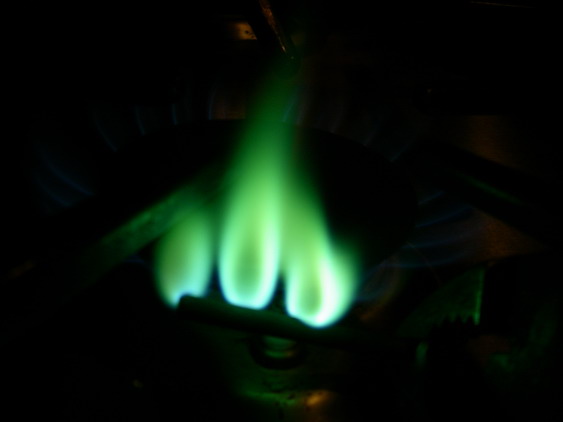
|
|
|
Baphomet
Hazard to Others
  
Posts: 211
Registered: 19-11-2006
Member Is Offline
Mood: No Mood
|
|
Hmm ok. The brown colour of copper chloride anhydrous is the most telling IMO for identification of your sample.
Try doing the reaction stoichiometrically so that the effects of different species and complexes are minimised.
For example CuSO<sub>4</sub> has a different complexes present when in solution depending on pH.
Tell me.. if you take a chunk of the brown stuff and leave it out for a while, does it turn green slowly?
BTW CuCl<sub>2</sub> should produce a green-blue flame since chlorine is a halide.
EDIT: nice pic! what is the result if you do the same with your initial sample of copper sulphate?
[Edited on 21-12-2006 by Baphomet]
|
|
|
UnintentionalChaos
International Hazard
    
Posts: 1454
Registered: 9-12-2006
Location: Mars
Member Is Offline
Mood: Nucleophilic
|
|
Good point about the halide complex...the flame seems so dramatically different if its in wood fire vs. butane/gas. It's very blue in wood fire, but
very green in butane/gas. That picture had an odd exposure. I will let some anhydrous material sit out to see if i get a color change...reporting back
tomorrow or whenever it happens/I've given up hope of it happening. Now I just have to get some anhydrous CuCl2 because I left it in denatured alcohol
solution. More heating and fumes..yay!
I did it stoichiometrically. Unfortunately my good scale hasn't arrived yet so I'm measuring grams with no decimal places on a postal scale...aside
from that I was also working with 1/10 moles since I do not have much CuSO4 until the batch in the garage finishes. I going to repeat this entire
experiment because I have no idea what the chrome and iron contamination has done to the color of this solution. All I can tell you is that it burns
very nicely as "campfire blue" (as CuCl2 is sold on skylighter) and whatever it turns out to be, I would repeat the process (except corroding my steel
pot) for pyro coloring purposes. Even a tiny bit of the solution gives a lot of brightly colored fire for a long time. If they ahd muriatic acid at
the hardware store I'd have a much more direct route to CuCl2.
[Edited on 21-12-2006 by UnintentionalChaos]
|
|
|
Baphomet
Hazard to Others
  
Posts: 211
Registered: 19-11-2006
Member Is Offline
Mood: No Mood
|
|
Cool let us know what happens. Your quest for the holy copper salt has drawn me in 
Here's some more info you might find useful:
- Dry the alcohol by mixing it with NaCl to absorb the water, then pouring the top layer off
- Use non-iodised salt for your source of NaCl in experiments
- An easy way of making CuCl<sub>2</sub> is to pour some H<sub>2</sub>O<sub>2</sub> onto copper wire then pour HCl
onto that. Use excess HCl to prevent CuCl formation. After reaction, evaporate.
- An even easier way is to add HCl to CuO then evaporate
- HCl on CuSO<sub>4</sub> won't get you to CuCl<sub>2</sub>
|
|
|
UnintentionalChaos
International Hazard
    
Posts: 1454
Registered: 9-12-2006
Location: Mars
Member Is Offline
Mood: Nucleophilic
|
|
Thanks for the many responses Baphomet. I have denatured alcohol. I thought this was fairly dry, but i may be wrong, so for the re-try I will
definetly dry it first. I did use un-iodized salt...i can think ahead there, but not for my poor steel pot  I went over the whole acid route about a week ago on another thread , but can't find pure enough HCl anywhere. If I
had black copper oxide, I would make thermite, not CuCl2...well maybe some CuCl2, but mostly thermite (I have maybe 15g from another confused string
of reactions that the only thing I could assure of was that when I roasted the last thing I managed to make, it turned pure, dark black and is
probably fairly uncontaminated CuO) When I massed the undissolvable components of the mix, it is obvious that about 6g of something ended up in the
alcohol solution and from the various burning tests there is definetly some copper in it. I will continue the quest tomorrow as it is now almost 4am
and I'm tired as hell. One more checkup on the CuSO4 being made in the garage and then I'm off to dreams about very clean, cheap, and abundant HCl I went over the whole acid route about a week ago on another thread , but can't find pure enough HCl anywhere. If I
had black copper oxide, I would make thermite, not CuCl2...well maybe some CuCl2, but mostly thermite (I have maybe 15g from another confused string
of reactions that the only thing I could assure of was that when I roasted the last thing I managed to make, it turned pure, dark black and is
probably fairly uncontaminated CuO) When I massed the undissolvable components of the mix, it is obvious that about 6g of something ended up in the
alcohol solution and from the various burning tests there is definetly some copper in it. I will continue the quest tomorrow as it is now almost 4am
and I'm tired as hell. One more checkup on the CuSO4 being made in the garage and then I'm off to dreams about very clean, cheap, and abundant HCl

|
|
|
UnintentionalChaos
International Hazard
    
Posts: 1454
Registered: 9-12-2006
Location: Mars
Member Is Offline
Mood: Nucleophilic
|
|
Success!
I ran the entire procedure again today, avoiding the mess I made yesterday, and came up with very good results. Everything was much better planned
this time. I started with as close to stoichiometric ratios as I could achieve with a postal scale and while working with 1/10 mol quantities: 2NaCl
to 1CuSO4*5H2O, or a little more than when the scale read 11g and when it read 25g, respectively. Both salts were dissolved in roughly 150ml of 100 C
water. The first photo shows the standard CuSO4 solution's color, while the second was taken immediately after adding the NaCl. This mix was heated in
the microwave on full power for 5 minutes. The third picture illustrates the further color change to dark green (indicating presence of CuCl3 (-1) and
CuCl4 (-2) complexes) This mixture was then heated for another ten minutes (cover to prevent hot salts from splattering everywhere) to bring to total
dryness. (Photograph 4) Dry denatured alcohol was used to "wash" the mixed salts until there was only a pale green color remaining (photograph 5). The
resulting solution in ethanol was a bright, strong green (photograph 6). This was heated outdoors in a crude double boiler to remove the ethanol. The
final product was fully dried in an oven to remove the last traces of ethanol and any water that may have seeped into the mix from the double boiler.
Picture seven is the fully dried product on a ghetto roasting crucible. Notice how there are some whitish patches on the surface of some granules.
This is presumably the formation of the dihydrate...which is progressing at an eerily rapid pace. The resulting product's mass was approximately 7g
(again, crappy postal scale, but more likely about 7.5g) Given the scale's lack of accuracy, this represents anywhere from a 50 to 60% conversion of
copper ions to CuCl2. Clearly not an ideal method, but certainly a plausible one if you happen to desperately want CuCl2 and have CuSO4 coming out the
wazoo.
Err..anybody able to tell me how to post multiple images without making more responses?
PS: found out how to do this, but I have no site to post them on, then use BB code to put them here. I apologize for the lazy route of using 6 more
responses
[Edited on 22-12-2006 by UnintentionalChaos]
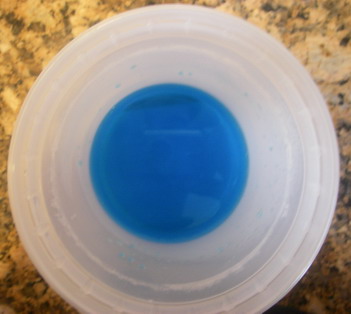
|
|
|
UnintentionalChaos
International Hazard
    
Posts: 1454
Registered: 9-12-2006
Location: Mars
Member Is Offline
Mood: Nucleophilic
|
|
After adding NaCl
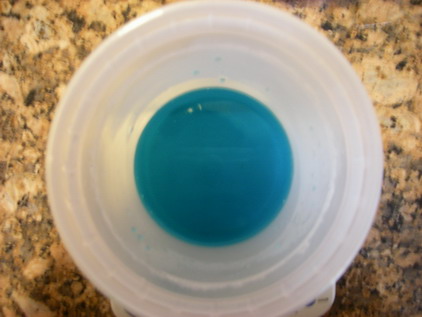
|
|
|
UnintentionalChaos
International Hazard
    
Posts: 1454
Registered: 9-12-2006
Location: Mars
Member Is Offline
Mood: Nucleophilic
|
|
After heating 5 minutes
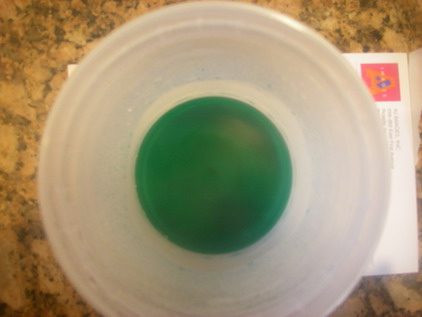
|
|
|
UnintentionalChaos
International Hazard
    
Posts: 1454
Registered: 9-12-2006
Location: Mars
Member Is Offline
Mood: Nucleophilic
|
|
The dry mix of salts. The white spots are presumably NaCl that precipitated out at the last moment.
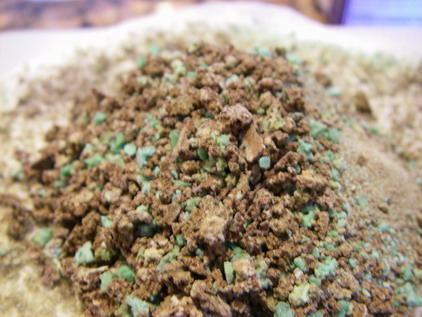
|
|
|
UnintentionalChaos
International Hazard
    
Posts: 1454
Registered: 9-12-2006
Location: Mars
Member Is Offline
Mood: Nucleophilic
|
|
Leaching the CuCl2 with dry ethanol. I tried your drying method, Baphomet, and had absolutely no dissolution of salt or seperation of NaCl saturated
layer. I also tried adding anhydrous CuSO4 to verify this result and no color change was observed when left to sit for a reasonable amount of time. In
reality, I just mixed all the dried material with ethanol, mixed it up, and ran it through filter paper, but I thought this picture showed what was
happening very well.
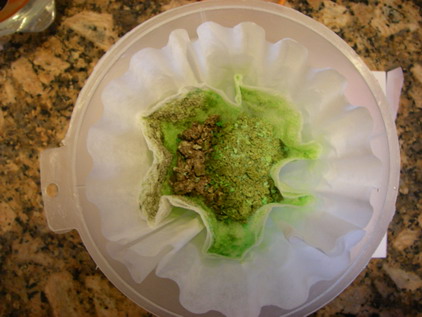
|
|
|
UnintentionalChaos
International Hazard
    
Posts: 1454
Registered: 9-12-2006
Location: Mars
Member Is Offline
Mood: Nucleophilic
|
|
Solution of presumed CuCl2 in ethanol.
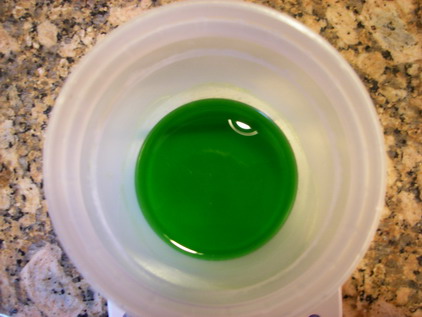
|
|
|
UnintentionalChaos
International Hazard
    
Posts: 1454
Registered: 9-12-2006
Location: Mars
Member Is Offline
Mood: Nucleophilic
|
|
The final dried product. Traces of dihydrate formation are visible.
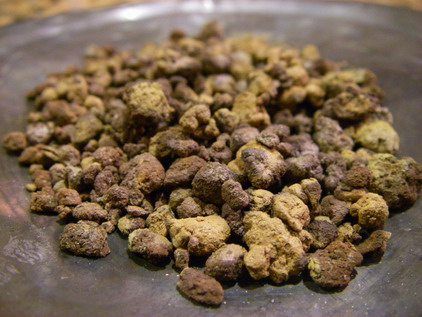
|
|
|
12AX7
Post Harlot
    
Posts: 4803
Registered: 8-3-2005
Location: oscillating
Member Is Offline
Mood: informative
|
|
Very nice, thanks for the pictures.
Tim
|
|
|
guy
National Hazard
   
Posts: 982
Registered: 14-4-2004
Location: California, USA
Member Is Offline
Mood: Catalytic!
|
|
Thats awesme! How good were the yields?
Ive also found that burining the CuCl2/EtOH soln is more fun and faster!
|
|
|
guy
National Hazard
   
Posts: 982
Registered: 14-4-2004
Location: California, USA
Member Is Offline
Mood: Catalytic!
|
|
| Quote: | Originally posted by Baphomet
Isn't Cl- more electronegative than SO4? |
No, SO4(2-) is mostly oxygen! It is a HARD base and prefers Na+ which is a HARD acid.
Cl- is also HARD but its softer than SO4(2-), and Cu2+ is borderline hardness only.
|
|
|
| Pages:
1
2 |